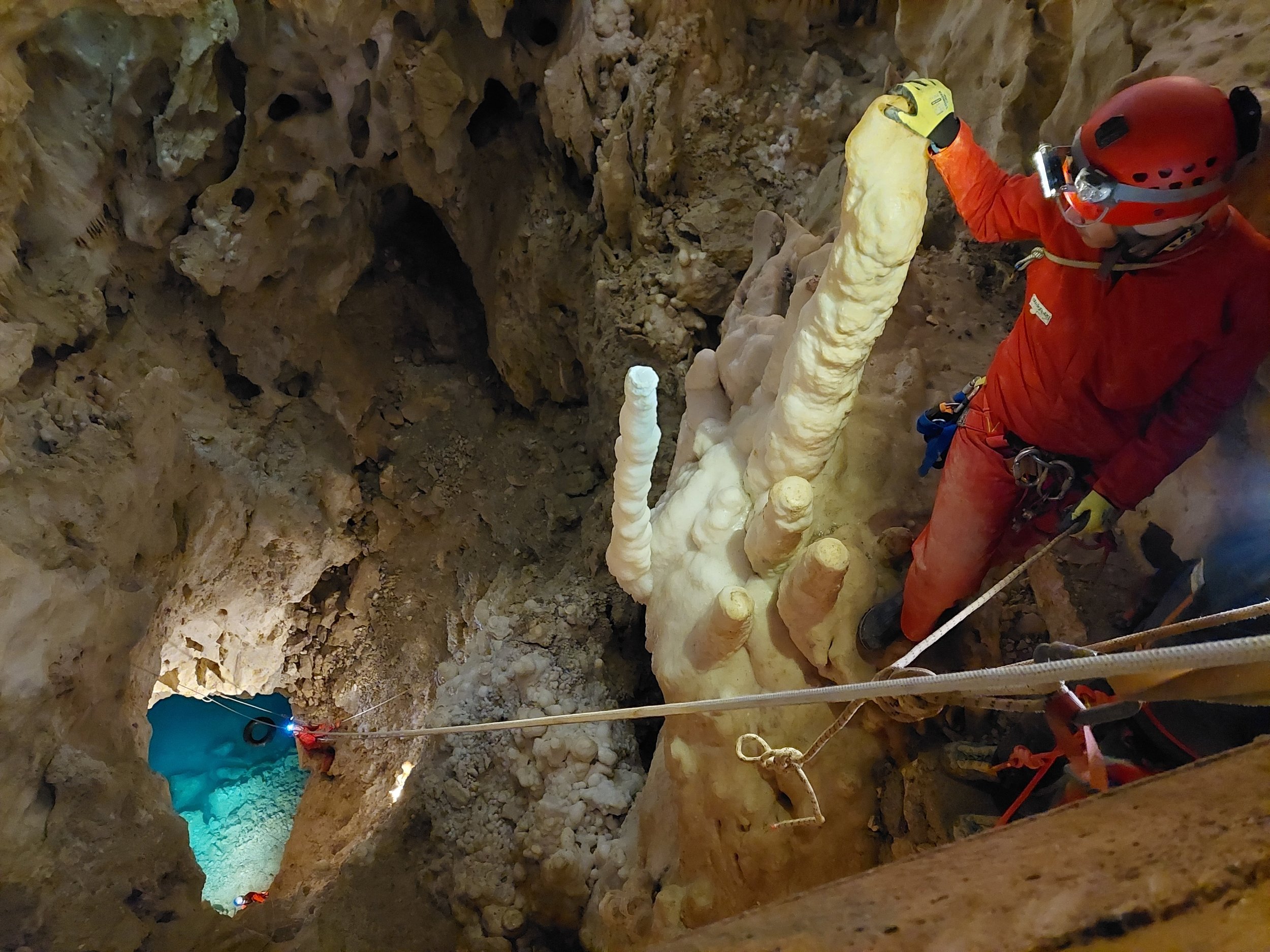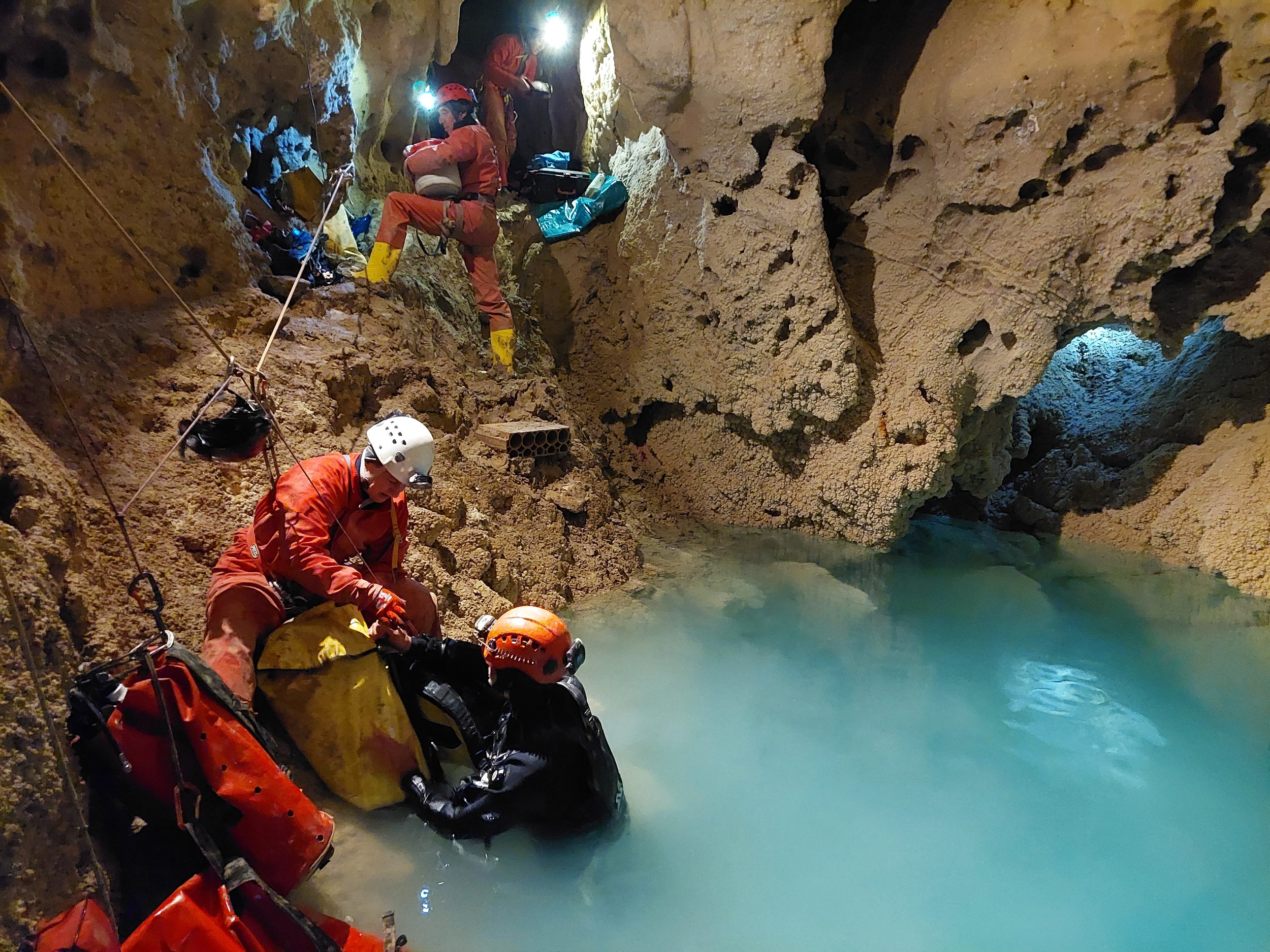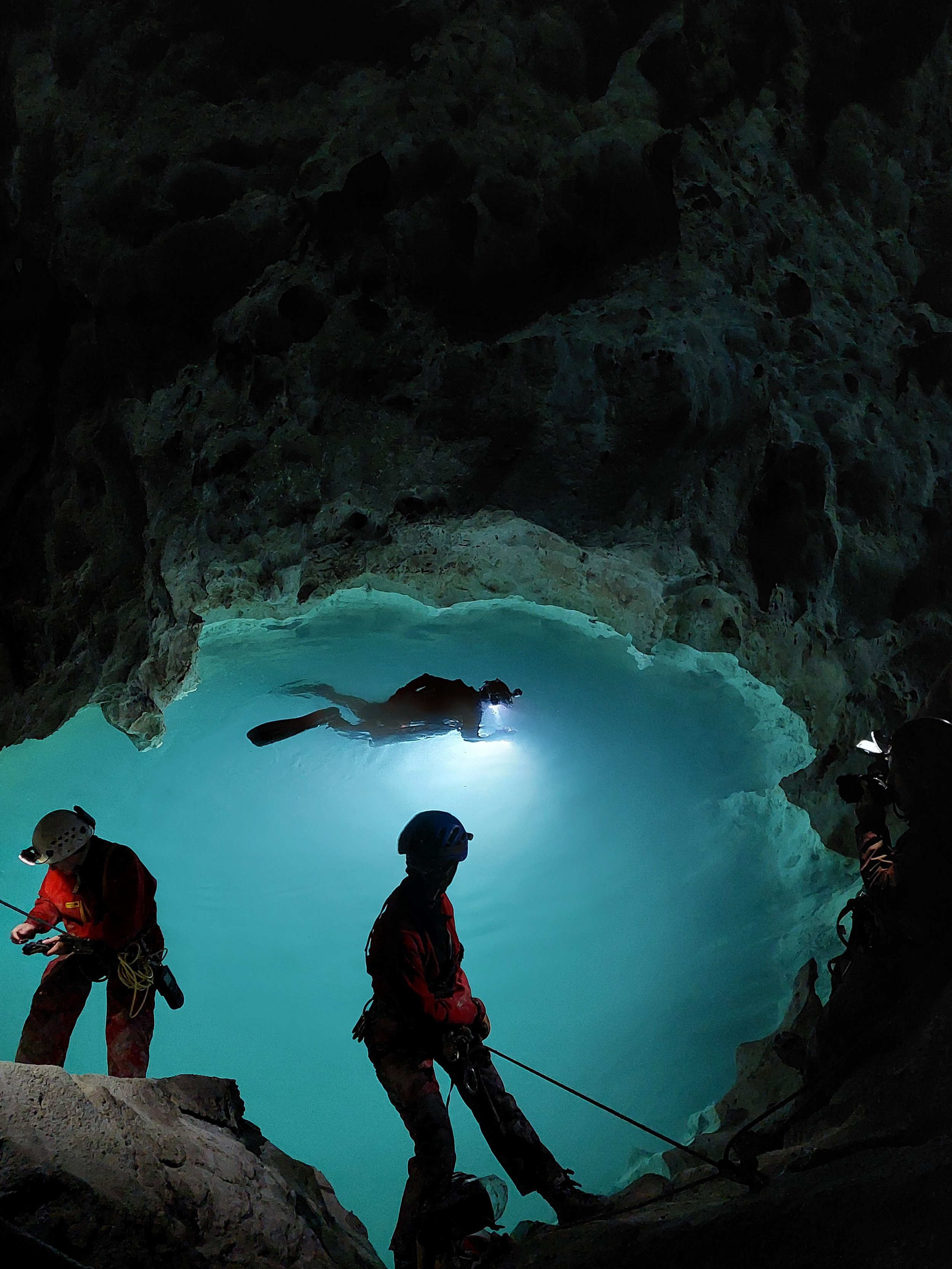Dani Buchheister

To start with, could you introduce yourself and tell us a little bit about your research?
My name is Dani Buchheister and I’m a second-year Ph.D. student at Penn State focusing on geomicrobiology and astrobiology. I study a microbial biofilm in caves in central Italy to learn how they survive down there.
I’m curious about how you got into science. What was your trajectory?
When I graduated high school, I went to the University of Florida, where I did a double major in business management and psychology. I picked something that felt like it would be practical and it was. It wasn’t hard to get a job. I worked in management at a Fortune 500 company for 4 years. But during the last year or two, it seemed like nothing I could do there would hold my interest for long. So I started asking myself: If I could just start over, what would I do?
At that point, I was listening to a lot of science podcasts and I felt like something I was missing in my job was learning and discovering new things. I eventually decided to go back to school entirely. So I quit my job and went to the University of Colorado, Boulder.
I had spent a lot of time thinking about what scientific discipline I might want to focus on and astrobiology seemed like a great choice—a middle ground between the vastness of space and the tangibility of life here on Earth. I decided the best way for me to achieve my astrobiology goal was to major in ecology and evolutionary biology, which allowed some flexibility. So that’s what I did and I’ve been on my science trajectory ever since!
Were you interested in science as a child or was that something that happened later?
I’m not one of the people who’s been memorizing constellations or playing with a microscope since I was a kid. I wasn’t particularly into science. I liked learning and reading, but I feel like my exposure to science was limited. I think this is generally true in the American school system: You tend to learn about the same subjects over and over again. I remember hating biology in high school and thinking: “I never want to do biology!” But as it turns out, I’m just not into human or animal anatomy, which is what a lot of high school biology focuses on. Once I found out about microbial biology, I was hooked.
You’re doing a lot of fieldwork for your graduate degree. Did you have any fieldwork experience before you started?
I didn’t have much fieldwork experience. In fact, I don’t consider myself a very outdoorsy person in general. I’m from Florida, and some people from Florida camp and hike, but you really have to leave the state to do those things effectively. So before I went back to school for field-based science, I had probably camped only once or twice in my life.
At CU Boulder, I got a little bit of field experience, but we mostly did day trips to nearby field sites. I did get to do a ten-day field geobiology course—to this day, that’s probably the most traditional fieldwork situation I’ve done. Going into caves for my Ph.D. has been a very new experience, but one that’s been a lot of fun.

On our trips to Italy, we stay at the Coldigioco Geological Observatory . We get up pretty early in the morning and make sure everything is packed: our cave gear, which means the suits we wear, the boots, the harnesses, and all the science equipment that’s coming with us into the caves. Then we drive out to the caves. Once we’re inside, we usually stay there for a good part of the day. So you bring everything you need. You bring your lunch, you bring snacks, you bring whatever you need to stay warm.
What we do in the cave depends on our goal for the day. A lot of it is interfacing with cave divers. We can’t collect the samples ourselves because they’re down in the water, meters down, in submerged cave passages. So we work with a handful of expert cave divers that my advisor has cultivated relationships with over the years. We need to make sure they have what they need and know what they’re looking for.
Then there’s a lot of waiting to see what the divers find. You never quite know what you’ll get.
What was your process of preparing for your first caving trip? Did you train for it?
Before I quit my management job, my partner and I had gone to Thailand on vacation and done a caving tour, so I had one day of guided caving experience, but I wanted to make sure I had spent some more time in caves before I was supposed to do it for science. Luckily, Penn State has a pretty active caving community. When I started my Ph.D., I went on some caving trips in Pennsylvania—just making sure I was comfortable crawling around and being in a cave all day.
Getting to our lakes in Italy can be especially tricky because we need to rappel down between 80 and 100 feet. I needed vertical training to make sure I would be safe going down. Before we went into the caves this February, we did vertical training with one of our caving collaborators in Italy. He had a shed by his house where we practiced coming down from a platform and climbing back up. Once we were actually in the caves, we also had the caving team double-checking all our gear and making sure we were doing it safely.
Can you tell us what’s special about these caves? Why are you interested in them as part of your astrobiology research?
The caves are sulfidic, so there’s a lot of sulfide in the system that is probably coming from the underlying rock. Inside, there are stratified lakes. The lakes have an oxygenated layer of freshwater on top. Beneath that is a layer with extremely low levels of oxygen and most of the other things that microbes breathe in modern surface environments. We know that on the early Earth, there was much less oxygen in the atmosphere than there is today, so these sulfidic, oxygen-poor waters are similar to what we think waters on the early Earth may have looked like. We can think of the cave system as an analog for the early Earth.
The biofilms in these lakes are interesting. We think of photosynthesis as forming the basis of most food chains on Earth, but these microbes live in the dark, so they’re not doing photosynthesis. They also don’t have oxygen down there, so they can’t breathe oxygen like we do. That really limits their options of getting energy from their environment.
Currently, there’s almost nothing in the scientific literature about this biofilm. We barely know what microbes are in it and we don’t really know what they’re doing. There’s a lot to learn!

So when your collaborators dive into the water, they’re taking samples of the biofilm and bringing up samples for you to study?
Yes, we give them big syringes and when they find the biofilm, which hangs down from the rocks in submerged passages, they suck up as much of the biofilm as they can and bring it to the surface.
What do you do with those samples?
It depends on the goal of the trip. For our trip in February, I had made up some liquid medium that we hoped some of these microbes would want to grow in. We brought the medium to Italy with us. When the divers came up with the biofilm, we’d immediately transfer the microbes to oxygen-free bottles, take them back to the lab, and I’d put a little bit of biofilm into the medium. Our goal is to grow microbes that might be doing interesting chemical reactions to get energy from their environment.
What has been the most challenging part of your fieldwork so far?
I think the most challenging part was keeping up my energy levels. Sometimes I would get back from 8 hours in the cave, eat dinner, and then go to the lab, trying to get things ready for the next day. When you do that several days in a row, it can be draining.
But it also was a lot of fun. My advisor did a really good job of making sure that everyone was comfortable and the work was accessible.
Building on what you just said about your advisor, how important has mentorship been in your trajectory?
Very important! I’ve been lucky to find really good mentors.
One of them became a mentor when I took her class. This was during COVID, so we were on Zoom. I was in the Zoom waiting room and suddenly she let me into the meeting. It was just the two of us in the meeting, so I said: “Oh, is nobody else here?” And she said: “No, I just wanted to let you in early to tell you you’re doing a great job.” She didn’t have to do that. It was so nice of her.
I ended up working in her lab and getting experience that directly helped me in the my current fieldwork. She introduced me to people and helped me to figure out what graduate programs would be good for me. I’ve been incredibly lucky.
How do you feel that stereotypes or prejudice have affected your education?
In the geosciences, there’s definitely a strong concept of what a geoscientist is. In my ecology program, there was also a heavy field component, but I felt like there wasn’t the same mythos of what a stereotypical field scientist should be like. It’s taking a little more time to acknowledge that geoscientists can look very different and have very different experiences and still be great geoscientists
In the first semester of my Ph.D., that made me insecure. I was sitting in geoscience classes going: “Oh, gosh, what did I get myself into? I’ve never done a field camp. I don’t own a rock hammer. I can’t name an entire list of minerals.” But becoming more confident in what I do has helped with that.
What do you think needs to change in your field to make it more accessible to women, BIPOC people, LGBT+ people, and others?
In the geosciences in particular, I think we need to reckon with the cost people are expected to take on to get field experience. Field camp is so important in undergraduate geoscience programs. It can be very expensive and the cost can be prohibitive. I didn’t have to go to field camp because I didn’t do a geology degree, but I think of having to give up an entire summer and spend thousands of dollars. As a non-traditional student coming back to school, I could not have afforded that. I needed to work over the summers and I needed to work for money. We need to ask ourselves as a field: How can we make sure field camp is an option for everyone and not just an option for people who can easily pay for it?

What advice would you give to girls and women who are interested in getting into field research?
I’d definitely suggest finding a supportive network. When I came back to school, there were so many things I did that were scary, but finding people who could guide me and support me gave me confidence and helped me feel like I belonged.
A lot of that support came from talking to professors about my goals and asking for their recommendations on what classes to take and what people to meet. Things like that helped a lot because I feel like I met the right people earlier than I would have otherwise.
For people who want to go to grad school, choosing your advisor is an important part of the process. They’re essentially your boss for years and you need to make sure it’s going to be a good working relationship. Often, more than the city you’ll be living in, more than the specifics of what you’re working on, that relationship can really dominate your experience. It’s important to find out ahead of time whether your advisor is supportive and communicative and whether they’ll handle your ups and downs well.
How would you recommend people find out if an advisor is a good fit?
Talking to their current grad students is important, but people who have worked with them in other capacities can be helpful, too. In my case, I asked people who knew my prospective advisors what they were like.
I also asked prospective advisors a lot of questions about their expectations for hours, their expectations for breaks, how they manage people, how they communicate, and so on. Those questions are standard in business interviews. We should be teaching people more of those skills in the sciences. They’re really helpful and they’re often overlooked.
What’s your favorite thing about your research?
It’s just so cool! When I was in the caves in February, I thought: “So few people have been where I am right now.” So few people get to experience that—and experience it with such an international, collaborative team. Especially with National Geographic there, we had people from Germany, we had people from Switzerland, we had people from Italy, we had some Americans flying in, so every night, it was like a crazy family dinner. We were all talking about our experiences, and it was such a vast range of experiences!
This interview has been edited and condensed for clarity. Images used with permission of Dani Buchheister.